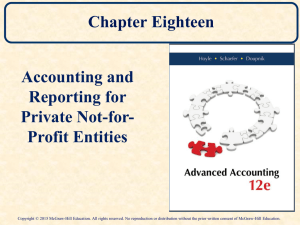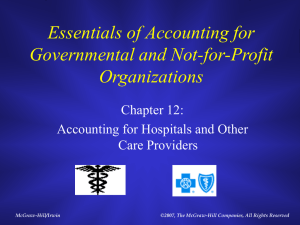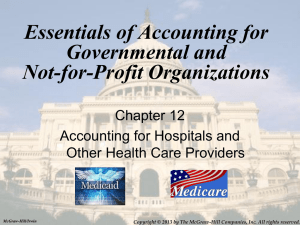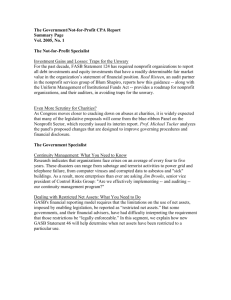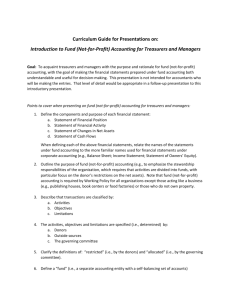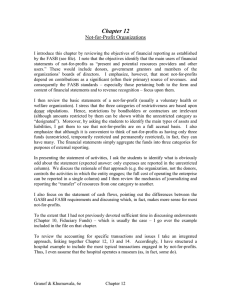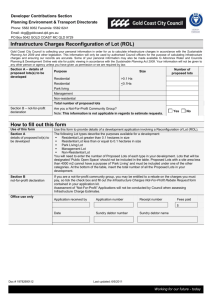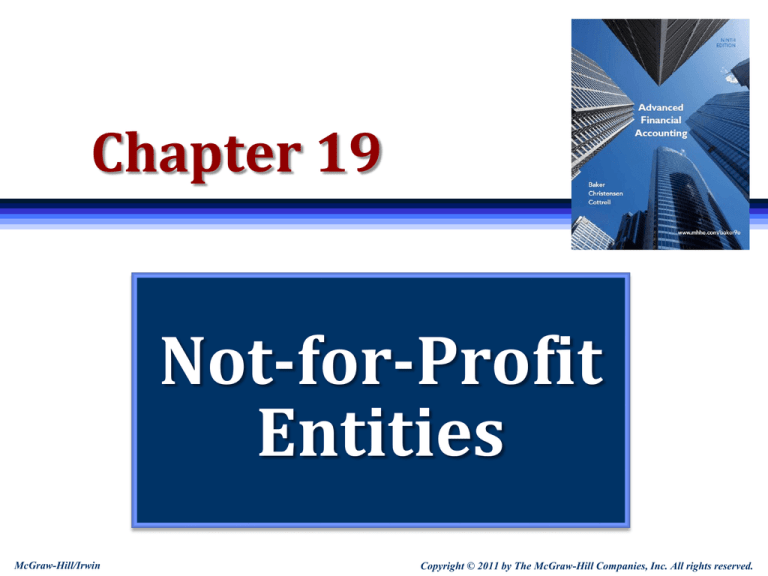
Chapter 19
Not-for-Profit
Entities
McGraw-Hill/Irwin
Copyright © 2011 by The McGraw-Hill Companies, Inc. All rights reserved.
Learning Objective 1
Understand financial
reporting rules and make
basic journal entries for
private, not-for-profit
entities.
19-2
Types of Not-for-Profit Organizations
Colleges and Universities
Health Care Organizations
Voluntary Health and Welfare
Organizations
Certain (or “all other”) Not-for-profit
Organizations
19-3
Excluded Entities
The following entities are not NPOs
because they solely serve the economic
interests of their owners, members,
participants, or trust beneficiaries:
Credit unions and mutual banks
Employee benefit and pension plans
Mutual insurance companies
Farms and rural cooperatives
Trusts
19-4
Characteristics of NPOs
No outside ownership interest
A mission to provide services
To their users, patients, society as a
whole, or members
But NOT at a profit
A dependence on significant levels of
contributions
A significant level of assets that are
restricted as to use because of donor
stipulations
Tax-exempt status. IRS Form 990, 990A, or 990PF
19-5
Dependence on Contributions and
Federal Funding
Not-for-profit religious, charitable, and
educational groups receive roughly $40
billion annually in federal government
grants.
19-6
Tax-Exempt Status
Advantages to Tax-Exempt Status for U.S.
Income Tax Reporting Purposes (in most
states):
No state income tax
No local property taxes
No sales taxes on purchases
19-7
Tax-Exempt Status
Private NPOs are exempt from U.S. income
taxes if the NPO:
Serves some common good.
Does not make an accounting profit.
Does not primarily benefit its own executives.
Does not function for political purposes.
19-8
Tax-Exempt Status
IRS Audits of Tax-Exempt Groups:
Annually, the IRS audits approximately 11,000
of the 1.2 million tax-exempt groups.
The IRS assesses taxes & penalties
of over $100 million per year.
Such taxes are on business-related income
(which is taxable at the highest corporate rate).
19-9
Differences between NPOs and Businesses
Revenues and support are often
compared to expenses. However,
remember that
Expenses are incurred to provide services
(rather than to generate revenues as in
commercial accounting).
The purpose of NPOs is not to maximize return
on an ownership interest.
ROE = Not Applicable
19-10
The Reporting Model: Private NPOs
The reporting model
Focuses on the flow of all economic resources
Uses the accrual basis of accounting
Recognizes depreciation expense in the
operating statement
The use of this reporting model reveals
The improvement or deterioration in the NPO’s
financial condition for the period and
Is similar to the model used in the commercial
sector
19-11
Who Makes the Rules for
Not-for-Profits Entities?
The accounting and
financial reporting for
governmental not-forprofit entities
GASB
Accounting and
financial reporting for
nongovernmental notfor-profit entities
FASB
19-12
Financial Reporting for Private,
Not-for-Profit Entities
Private, not-for-profit entities must
report their net assets in accordance with
FAC 6.
FAC 6 specifies three mutually exclusive
classes of net assets:
Unrestricted net assets
Temporarily restricted net assets
Permanently restricted net assets
19-13
Financial Reporting for Private,
Not-for-Profit Entities
Important FASB Standards
SFAS 93 guides depreciation
SFAS 116 guides accounting for contributions
SFAS 117 establishes financial display
requirements
SFAS 124 establishes the accounting for
investments
SFAS 136 guides the accounting for transfers of
assets to a not-for-profit organization that raises
or holds contributions for others
19-14
Financial Reporting for Private,
Not-for-Profit Entities
Some not-for-profit entities use a fund
structure to account for each type of net
asset class.
Other not-for-profit entities maintain
only an accounting record to show the
amounts in each net asset class.
The specific identification of any restricted
asset must be made when the asset comes into
the entity, generally by donation or bequest.
19-15
Financial Reporting for Private,
Not-for-Profit Entities
Mergers and acquisitions—Exposure drafts
The proposed standards
Require the recognition of identifiable assets
acquired and liabilities assumed at their fair values
at the date of the acquisition
Require that intangible assets other than goodwill
and goodwill be assigned to reporting units that are
acquired
Approaches to evaluating goodwill impairment
Qualitative Evaluation Method
Fair-Value-Based Evaluation
19-16
Contributions: Scope of FAS 116
FAS 116, “Accounting for Contributions”
applies to ALL 4 types of Private NPOs.
Health Care Organizations
FASB
116
Colleges and Universities
Voluntary Health and Welfare
Organizations
Certain Other NPOs
19-17
Contributions: Defined
Contribution
An unconditional (no strings attached) transfer
of
1. Cash or
2. Other Assets
In a voluntary, nonreciprocal transfer.
By a person or entity acting other than as an
owner of the NPO
Examples of Other Assets: Equipment,
vehicles, land, and promises of cash.
19-18
Contributions: “Promises, Promises”
“Unconditional transfers” include
“unconditional promises” to give cash or
other assets in the future.
Promises may be
Oral or
Written
Unconditional promises result in reporting
“Contributions Receivable” in the balance
sheet (subject to an allowance for
uncollectibles).
19-19
Contributions: Recognizing Unconditional
Promises
Recognizing unconditional promises in
the financial statements requires
having sufficient evidence
in the form of verifiable documentation
that a promise was made
19-20
Contributions: “Conditional” Promises to Give
Conditional promises
The conceptual opposite of unconditional
promises to give
Not contributions (as defined by FAS 116)
Depend on the occurrence of a specified future
and uncertain event that
Must occur to bind the promissor and
Thus transform the promise from conditional to
unconditional status.
19-21
Contributions: “Conditional” Promises That May
Be Deemed “Unconditional”
A conditional promise may be deemed
unconditional if:
“The possibility that the future event will not
be met [occur] is remote.”
Event not likely to occur =
Event likely to occur
=
Conditional
Unconditional
19-22
Contributions: “Conditional” Use of Assets
Received
If assets have been received and the
retention and use of such assets is
conditional upon a future event that is
not likely to occur,
The offsetting credit is to a Refundable
Advance account (a liability)
Until the conditional event occurs.
19-23
Contributions: Manner of Reporting By Category
Contributions are reported in the
Statement of Activities (the operating
statement) by category
Unrestricted
Temporarily restricted
Permanently restricted
19-24
Contributions: Manner of Reporting By Category
Donor-restricted contributions whose
conditions are fulfilled in the same period
in which the contribution is recognized
May be reported in the unrestricted category of
the operating statement (O/S) if the entity:
Consistently follows this policy and
Discloses this policy.
Note: This option negates the need to show
transfers between categories in the
Operating Statement.
19-25
Contributions: Endowments
Endowments
A contribution that cannot be spent.
The unspendable amount is called the
principal—it is invested in perpetuity.
Income on Endowments
Donor stipulations dictate the reporting
classification (unrestricted, temporarily
restricted or permanently restricted).
19-26
Contributions: Temporary Restrictions
Contributed Assets
that are restricted as to either
Purpose
or
are classified as
Time Period
Temporarily
Restricted
Assets
19-27
Contributions: Expirations of Restrictions
Manner of Reporting Expirations
of Restrictions:
Where: In the statement of activities.
How: As a separate line item reclassification as
shown below.
Expirations of restrictions
Unrestricted
Temporarily
Restricted
$77,000
$(77,000)
19-28
Contributions: Delayed Discussion of
Additional Issues
The following issues
Are covered after we discuss FAS 117 “Financial
Statements of Not-for-Profit Organizations”
So that you may more readily see the close
interrelation-ship that exists between FAS 116
and FAS 117.
Valuation
Contributed services
Collection items
19-29
Financial Statements: Scope of FAS 117
FAS 117, “Financial Statements of Notfor-profit Organizations” applies to ALL
4 types of Private NPOs.
Health Care Organizations
FASB
117
Colleges and Universities
Voluntary Health and Welfare
Organizations
Certain Other NPOs
19-30
Financial Statements: FAS 117—The Basic
Requirements
FAS 117 specifies:
What financial statements are to be presented.
What specific information, as a minimum, is to
be shown.
19-31
Financial Statements: Which Financial
Statements
FAS 117 requires for the NPO as a whole:
A Statement of Financial Position
A Statement of Activities
A Statement of Cash Flows.
VH&WOs must also report
In a separate statement
Expenses by Natural Classification in a matrix
format.
19-32
Financial Statements: The Three
Classifications of Net Assets
The three mandated classifications of net
assets are:
Unrestricted.
Temporarily restricted.
Permanently restricted.
Note that these are the same three
classifications used for reporting
contributions.
19-33
Contributions: Additional Issues
Contributions of monetary and
nonmonetary assets are valued at the fair
value of the assets received.
Determining the fair value may require
Obtaining quoted market prices.
Using independent appraisals.
Using other appropriate methods.
19-34
Contributions: Additional Issues
Use of Present Value Procedures:
Can use for estimated future cash flows on
unconditional promises to contribute that are
expected to be collected over a period of longer
than one year.
If used, subsequent recognition of
the interest element is reported as contribution
income—not as interest income.
19-35
Contributions: Additional Issues
Contributed Services
Recognize as revenues only if:
Nonfinancial assets are created or enhanced.
Specialized skills are provided by individuals
possessing these skills (e.g., carpenters, electricians,
plumbers, lawyers, CPAs).
Required Disclosures for Contributed Services:
A description of the nature and extent
The amounts recognized as revenues
The programs or activities in which the services were
used
19-36
Contributions: Additional Issues
Contributed Services:
Recognizable contributed services are usually
recorded as revenues at the fair value of the
services contributed.
Allowed alternative valuation method for the
creation or enhancement of nonfinancial assets:
May value at the fair value of
the asset created or
asset enhancement
19-37
Contributions: Additional Issues
“Collection items” (the exception):
Consist of contributed works of art, historical
treasures, and similar assets.
Need not be recognized in the financial
statements if three conditions are satisfied [how
used, how cared for, and use of proceeds upon
sale].
Cannot be capitalized on a selective or arbitrary
basis.
19-38
Practice Quiz Question #1
How do not-for-profit entities differ from forprofit businesses:
a. Not for profit entities are prohibited from
charging more than cost for goods or
services provided while for-profit
businesses may include a mark up.
b. Both for-profit businesses and not-forprofit organizations are tax exempt.
c. Not-for-profit entities rely heavily on
contributions and grants while for-profit
businesses rely on profitable operations for
survival.
19-39
Learning Objective 2
Understand financial
reporting rules and make
basic journal entries for
not-for-profit colleges and
universities.
19-40
Colleges and Universities
Special conventions of revenue and
expenditure recognition
Tuition and fee remissions/waivers and
uncollectible accounts
The full amount of the standard rate for tuition and
fees is recognized as revenue
Accounting for university-sponsored scholarships,
fellowships, tuition and fee remissions or waivers
depends on whether the recipient provides any
services to the university
19-41
Colleges and Universities
Special conventions of revenue and
expenditure recognition
Tuition and fee reimbursements for withdrawals
from coursework
Accounted for as a reduction of revenue
Academic terms that span two fiscal periods
Accounted for as revenue in the fiscal year in which
the term is predominantly conducted, along with all
expenses incurred
NACUBO recommended the use of the accrual basis of
accounting
19-42
Colleges and Universities
Board-designated funds
The board may designate unrestricted current
fund resources for specific purposes.
FASB 117 specifies that these funds may not be
reported as restricted net assets because only
external, donor-imposed restrictions can result
in restricted net assets.
19-43
Colleges and Universities
Public colleges and universities
Accounting and reporting is specified by the
GASB.
GASB 35 requires that they follow the standards
for governmental entities as specified in GASB 34.
Most public institutions will be special-purpose
government entities engaged in only businesstype activities.
These entities present only the financial
statements required for enterprise funds and
then are included as component units of the state
government.
19-44
Colleges and Universities
Private colleges and universities
The FASB specifies the accounting and financial
reporting standards.
The three financial statements required are:
The Statement of Financial Position
The Statement of Activities
The Statement of Cash Flows
They are free to select any account structure that
best serves their management and financial
reporting needs.
19-45
Colleges and Universities
Overview of the Accounting and Reporting of Colleges and Universities
19-46
Colleges and Universities
Overview of the Accounting and Reporting of Colleges and Universities
19-47
Practice Quiz Question #2
Which of the following statements accurately
describes differences between the accounting
public and private universities?
a. Both public and private universities follow
FASB rules.
b. Both public and private universities follow
GASB rules.
c. Public universities follow GASB rules while
private universities follow FASB rules.
d. Public universities follow FASB rules while
private universities follow GASB rules.
19-48
Learning Objective 3
Understand financial
reporting rules and make
basic journal entries for
not-for-profit health care
providers.
19-49
Health Care Providers
Hospital accounting
Investor-owned hospitals provide the same
types of financial reports as commercial entities.
Not-for-profit hospitals present their financial
results using a specific format required by the
FASB.
Governmental hospitals follow the GASB’s
accounting and reporting requirements and are
considered special-purpose entities engaged in
business-type activities.
19-50
Health Care Providers
Hospital fund structure
Although not required to do so, many hospitals
have used a fund accounting structure for
accounting purposes.
Operating activities are carried on in the general
fund, and a series of restricted funds can be used
to account for assets whose use has been
restricted by the donor.
19-51
Health Care Providers
Overview of the Hospital Accounting and Reporting
19-52
Health Care Providers
Financial statements for a not-for-profit
hospital
Separate, not-for-profit hospitals issue four basic
financial statements
The Balance Sheet
The Statement of Operations
The Statement of Changes in Net Assets
The Statement of Cash Flows
19-53
Health Care Providers
Not-for-profit hospital: The Balance Sheet
Presents the total assets, liabilities, and net
assets of the organization as a whole
Major accounts
Receivables
Investments
Initially recorded at cost if purchased or at fair value
at the date of receipt if received as a gift
Plant assets
Property, plant, and equipment reported with any
accumulated depreciation
19-54
Health Care Providers
Not-for-profit hospital: The Balance Sheet
Assets whose use is limited
Long-term debt
Separate disclosure should be made for assets that
have restrictions placed on their use
The hospital must also account for its long-term debt
and pay the principal and interest as it becomes due
Net Assets
1. Unrestricted net assets available
2. Temporarily restricted net assets available for use
3. Permanently restricted net assets
19-55
Health Care Providers
Not-for-profit hospital: The Statement of
Operations
Also often termed “the statement of activities”
Includes the revenues, expenses, gains and
losses, and other transactions affecting the
unrestricted net assets during the period
Only general fund transactions are reported
Should report an operating performance
indicator
19-56
Health Care Providers
Not-for-profit hospital: Major accounts in
The Statement of Operations
Net patient service revenue
Contractual adjustments
Income from ancillary programs
Interfund transfers
General fund expenses
Donations
19-57
Health Care Providers
Not-for-profit hospital: The Statement of
Changes in Net Assets
It presents the changes in all three categories of
net assets
Unrestricted
Temporarily restricted
Permanently restricted
Statement of Cash Flows
Its format is similar to that for commercial
entities
19-58
Health Care Providers
Summary of hospital accounting and
financial reporting
Major operating activities take place in the
general fund.
The restricted funds are holding funds that
transfer resources to the general fund for
expenditures upon satisfaction of their
respective restrictions.
General fund uses the accrual basis of
accounting.
Patient services revenue is reported at gross
amounts measured at standard billing rates.
19-59
Health Care Providers
Summary of hospital accounting and
financial reporting
A deduction for contractual adjustments is then
made to arrive at net patient services revenue.
Other revenue is recognized for ongoing
nonpatient services.
Charity care services are presented only in the
footnotes; no revenue is recognized for them.
19-60
Health Care Providers
Summary of hospital accounting and
financial reporting
Operating expenses in the general fund include
depreciation, bad debts, and the value of recognized
donated services that are in support of the basic
services of the hospital.
Not all donated services are recognized.
Donated property and equipment are typically recorded
in a restricted fund until placed into service, at which
time they are transferred to the general fund.
Donated assets are recorded at fair values at the date of
gift.
19-61
Practice Quiz Question #3
Which of the following is false with respect
to not-for-profit hospital accounting?
a. Not-for-profit hospitals follow FASB rules.
b. Not-for-profit hospitals usually use fund
accounting.
c. Not-for-profit hospitals do not prepare a
statement of cash flows.
d. The general fund of not-for-profit
hospitals uses the accrual basis of
accounting.
19-62
Learning Objective 4
Understand financial reporting
rules and make basic journal
entries for not-for-profit
voluntary health and welfare
organizations.
19-63
Voluntary Health and Welfare Organizations
Voluntary health and welfare
organizations (VH&WOs) provide a
variety of social services
They solicit funds from the community at large
and typically provide their services for no fee.
VH&WOs are typically audited.
The federal government normally provides them
tax-exempt status.
19-64
Voluntary Health and Welfare Organizations
Accounting for a VH&WO
Similar to other not-for-profit organizations
except for special financial statements that
report on the important aspects of VH&WOs.
The accrual basis of accounting is required.
VH&WOs have been free to use fund accounting
in their accounting and reporting processes.
19-65
Voluntary Health and Welfare Organizations
Financial statements for a VH&WO
Statement of Financial Position
Statement of Activities
Statement of Cash Flows
Statement of Functional Expenses
The statements are designed primarily
for those who are interested in the
organization as “outsiders.”
19-66
Voluntary Health and Welfare Organizations
The Statement of financial position for a
VH&WO
Major balance sheet accounts:
Pledges from donors
Investments
Land, buildings, and equipment
Liabilities
Net assets
19-67
Voluntary Health and Welfare Organizations
Statement of activities
The overall structure of the statement of
activities for voluntary health and welfare
organizations and other not-for-profit entities
should be very similar as a result of FASB 117.
19-68
Voluntary Health and Welfare Organizations
Statement of activities
Public support
Revenues
The primary source of funds is likely to be
contributions from individuals or organizations that
do not derive any direct benefit from the VH&WO for
their gifts.
Funds received in exchange for services provided or
other activities
Gains
Gain or loss on sale of investments and other assets
19-69
Voluntary Health and Welfare Organizations
Statement of activities
Donated materials and services
Expenses
Should be recorded at fair value when received
Information about the major costs of providing
services to the public, fund-raising, and general and
administrative costs
Costs of informational materials that include
a fund-raising appeal
Many VH&WOs prefer to classify such costs as
program rather than fund-raising
19-70
Voluntary Health and Welfare Organizations
Statement of Cash Flows
The format of this statement is similar to that for
hospitals.
Statement of Functional Expenses
Details the items reported in the expenses
section of the statement of activities
19-71
Voluntary Health and Welfare Organizations
Summary of Accounting and Financial
Reporting for VH&WOs
Reporting requirements are specified in FASB
116, FASB 117, and the AICPA Audit and
Accounting Guide for Not-for-Profit
Organizations.
The accrual basis of accounting is used.
Primary activities are reported in the
unrestricted asset class.
19-72
Voluntary Health and Welfare Organizations
Summary of Accounting and Financial
Reporting for VH&WOs
Resources restricted by the donor for specific
operating purposes or future periods are
reported as temporarily restricted assets.
Assets contributed by the donor with permanent
restrictions are reported as permanently
restricted assets.
19-73
Practice Quiz Question #4
Which of the following is false with respect
to the accounting for voluntary health and
welfare organizations?
a. VH&WOs solicit funds from the
community and typically provide their
services for no fee.
b. VH&WOs use the modified accrual basis
of accounting.
c. VH&WOs must provide a statement of
cash flows.
d. VH&WOs primary activities are
reported in the unrestricted asset class.
19-74
Learning Objective 5
Understand financial reporting
rules and make basic journal
entries for other
not-for-profit organizations.
19-75
Other Not-for-Profit Entities
Examples of other not-for-profit organizations
(ONPOs):
Cemetery organizations
Civic organizations
Fraternal organizations
Labor unions
Libraries
Museums
Other cultural institutions
Performing arts
organizations
Political parties
Private and community
foundations
Private elementary and
secondary schools
Professional associations
Public broadcasting stations
Religious organizations
Research and scientific
organizations
Social and country clubs
Trade associations
Zoological and botanical
societies
19-76
Other Not-for-Profit Entities
Accounting for ONPOs
In addition to FASB 116 and FASB 117, the
AICPA Audit Guide for Not-for-Profit
Organizations provides guidance for accounting
and financial reporting standards.
While accrual accounting is required for all
ONPOs, some small organizations operate on a
cash basis during the year and convert to an
accrual basis at year-end.
19-77
Other Not-for-Profit Entities
Accounting for ONPOs
With the adoption of FASB 116 and FASB 117,
the procedures used by ONPOs and VH&WOs
may move away from the traditional funds used
They may account for all transactions in a single
entity or by establishing separate accounts for
unrestricted, temporarily restricted, and
permanently restricted net assets
19-78
Other Not-for-Profit Entities
Financial Statements of ONPOs
Explains how the available resources have been used to
carry out activities.
They should disclose the nature and source of the
resources acquired, any restrictions on the resources,
and the principal programs and their costs.
They should also provide information on the ability to
continue to carry out objectives.
FASB 117 requires
1. A Statement of Financial Position
2. A Statement of Activities, and
3. A Statement of Cash Flows
19-79
Other Not-for-Profit Entities
Summary of Accounting and Financial
Reporting
Accounting is similar to that for VH&WOs.
The accrual basis of accounting is used .
When a large number of programs or a number of very
different types of programs are part of the operations, it
may be desirable to prepare a statement of expenses by
functional area or major program as well.
As a result of FASB 116 and FASB 117, the reporting
requirements of ONPOs are substantially the same as
VH&WOs.
19-80
Practice Quiz Question #4
Which of the following is false with respect to
the accounting other not-for-profit
organizations?
a. While accrual accounting is required for all
ONPOs, some small organizations operate on
a cash basis during the year and convert to an
accrual basis at year-end.
b. Accounting is similar to that for VH&WOs.
c. ONPOs may account for all transactions in a
single entity or by establishing separate
accounts for unrestricted, temporarily, and
permanently restricted net assets
d. ONPOs follow GASB rules.
19-81
Conclusion
The End
19-82

